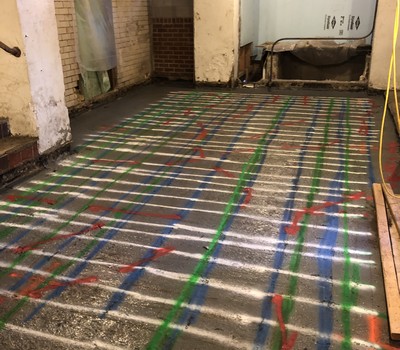RainierGPR Service Areas: Comprehensive Coverage for Concrete Scanning
RainierGPR Service Areas: Comprehensive Coverage for Concrete Scanning
Blog Article
Concrete Scanning: A Crucial Step In The Direction Of Guaranteeing Structural Integrity and Safety And Security
In the world of building and construction and infrastructure maintenance, the importance of concrete scanning can not be overstated. This precise process holds the essential to revealing possible dangers concealed beneath the surface area of seemingly solid structures. By using sophisticated modern technology and methods, concrete scanning functions as a crucial device in making sure that the stability and safety of structures and bridges are upheld to the highest possible standards. However, past its surface-level implications, the role of concrete scanning prolongs far much deeper than fulfills the eye.
Value of Concrete Scanning
Concrete scanning plays a vital role in making certain the structural integrity and security of buildings and facilities projects. By utilizing innovative modern technologies such as ground-penetrating radar (GPR) and electromagnetic induction, professionals can non-destructively inspect concrete structures to find possible defects, spaces, ingrained things, and support format. This procedure allows early detection of anomalies that can endanger the stability of a structure, avoiding costly damages and making sure the security of residents.
Prior to exploration, reducing, or coring right into concrete, scanning helps identify the exact places of rebar, post-tension cable televisions, and various other ingrained aspects, reducing the risk of unintentional hits that might lead to structural weaknesses. In addition, concrete scanning aids in top quality control by confirming the density of concrete covers and detecting any type of inconsistencies that might affect the overall sturdiness of the framework.
Modern Technology for Concrete Examination

Benefits of Very Early Detection
Timely detection of architectural problems can dramatically mitigate dangers and make sure the durability of building projects. By determining possible problems beforehand in the building and construction procedure, stakeholders can take proactive procedures to resolve concerns before they intensify into bigger and more expensive problems. Among the key benefits of early discovery is the avoidance of architectural failures, which can present severe security risks and result in project delays and economic losses.
Moreover, very early discovery permits timely repair services and maintenance, which can assist extend the life expectancy of the framework. By dealing with issues immediately, building and construction groups can prevent costly repair services or also the need for early substitute of structural parts. This proactive technique not just saves time and cash but likewise boosts the total security and durability of the building job.
In addition, very early detection can boost job preparation and decision-making by providing stakeholders with valuable understandings right into the condition of the structure. Armed with this details, task managers can make informed choices relating to building and construction methods, materials, and timelines, bring about more effective and efficient project outcomes.
Making Certain Structural Stability
Making sure the structural security of a construction job is critical to its safety and longevity. Architectural security refers to link the capability of a structure or infrastructure to maintain its kind and feature under ecological problems and different lots. To achieve this, detailed evaluation and tracking of the structure are vital. Concrete scanning plays a crucial function in making sure structural stability by identifying possible issues such as voids, delamination, or reinforcement deterioration that can jeopardize the integrity of the structure over time.
By utilizing innovative scanning technologies like ground-penetrating radar (GPR) and electromagnetic induction, building specialists can non-invasively check concrete why not try this out frameworks to determine areas of worry under the surface. This aggressive approach enables the very early detection of flaws or weaknesses, making it possible for punctual fixings or reinforcement to avoid architectural failings.
Normal concrete scanning throughout various building stages and throughout the life cycle of a framework can help preserve its security, reduce risks, and ensure the safety and security of residents. By prioritizing architectural stability with concrete scanning, construction projects can improve their resilience and toughness, eventually adding to greater security and long life.
Avoiding Important Failures
To guard against tragic events, thorough surveillance and aggressive maintenance are important in avoiding essential failings within architectural frameworks. Identifying possible concerns before they escalate is crucial to avoid structural failures. Executing regular examinations, such as concrete scanning, can expose concealed problems like voids, cracks, or corrosion that can compromise the honesty of a structure. By making use of innovative scanning technologies like Ground Permeating Radar (GPR) or Concrete X-ray, designers can non-destructively assess the condition of concrete and determine weak factors that require support or repair service - RainierGPR Service Areas.

Final Thought
To conclude, concrete scanning plays an important function in making certain architectural honesty and safety by using advanced innovation for very early detection of potential concerns. This positive approach assists prevent critical failures and guarantees the stability of frameworks. It is necessary Continue to prioritize concrete evaluation as a typical method to shield the durability and security of structures and infrastructure.
Concrete scanning plays a vital function in making certain the architectural integrity and safety of structures and facilities tasks. Furthermore, concrete scanning help in top quality control by verifying the density of concrete covers and spotting any type of discrepancies that may affect the total toughness of the structure. Concrete scanning plays an essential duty in making sure architectural security by detecting potential concerns such as spaces, delamination, or support corrosion that can compromise the stability of the structure over time.

In final thought, concrete scanning plays an important function in making certain structural honesty and security by making use of advanced innovation for very early detection of potential concerns.
Report this page